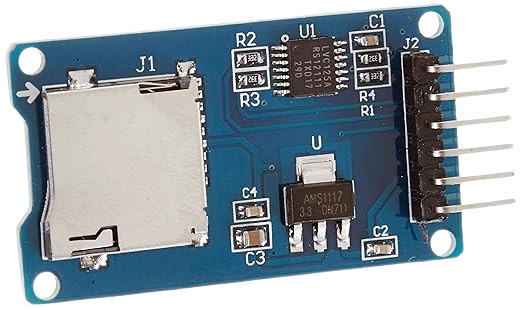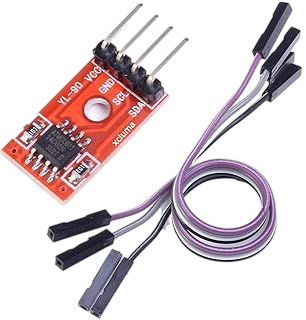Best SD Card Module for Data Logging in Electronics Projects – Full Guide, Uses, and Setup

Overview
What is an SD Card Module?
An SD Card Module is a compact device designed to provide external storage functionality to electronic circuits and embedded systems. It acts as a bridge between a microcontroller (like Arduino, Raspberry Pi, STM32, etc.) and an SD or microSD card, enabling reliable data read/write operations.
It is widely used in data logging, sensor monitoring, automation, robotics, and real-time event tracking applications where onboard memory is insufficient.
How Does an SD Card Module Work?
SD Card Modules operate on SPI (Serial Peripheral Interface) protocol, allowing them to communicate with microcontrollers using four main lines:
-
MISO (Master In Slave Out)
-
MOSI (Master Out Slave In)
-
SCK (Serial Clock)
-
CS (Chip Select)
Key Features of SD Card Modules
-
Supports standard SD and microSD cards up to 32GB (FAT16/FAT32 format)
-
Operates on 3.3V logic (some modules include 5V–3.3V regulators)
-
Plug-and-play interface with embedded boards
-
High read/write reliability
- Compact and lightweight design
-
Commonly supports SPI interface
Applications of SD Card Modules
-
Long-term data logging
-
Sensor value storage in automation setups
-
Offline data collection for field devices
-
Real-time event logging
-
Storage of text, CSV, or binary files
- Monitoring systems where internet is not required
Types of SD Card Modules
| Type | Description |
|---|---|
| Standard SD Card Module | Supports full-size SD cards, generally larger in size. Suitable for legacy systems. |
| MicroSD Card Module | Compact design supporting microSD cards, ideal for modern embedded boards. |
| Buffered SD Modules | Includes additional capacitor/resistor protection for noisy environments. |
| High-Speed SD Modules | Supports faster SPI speeds and advanced microcontroller platforms. |
Technical Specifications
-
Input Voltage: 3.3V or 5V (depends on module)
-
Logic Level: 3.3V
-
Interface: SPI
-
File System Support: FAT16/FAT32
-
Card Capacity: Up to 32GB (standard modules)
-
Dimensions: Vary by module type
-
LED Indicator: Optional on some models
How to Interface an SD Card Module with Microcontroller
Required Components:
- SD Card Module (microSD)
- Microcontroller Board (like Arduino Uno)
- MicroSD Card (FAT32 formatted)
- Jumper wires
- Breadboard (optional)
Typical Wiring:
| SD Card Module Pin | Connect To (Arduino Uno) |
|---|---|
| GND | GND |
| VCC | 5V |
| MISO | Pin 12 |
| MOSI | Pin 11 |
| SCK | Pin 13 |
| CS | Pin 10 |
Practical Example: Storing Sensor Data into SD Card
Objective:
Save simulated temperature data into a .txt file stored in an SD card using basic file operations.
Code Example (Arduino-Compatible):
Output on SD Card:
Common Issues & Fixes
| Problem | Solution |
|---|---|
| SD Card not initializing | Check wiring and SD card format (must be FAT16/FAT32) |
| “Error opening file” message | Ensure correct chip select (CS) pin is used |
| Unstable write/read behavior | Use quality SD card and ensure stable power supply |
| Random characters in data file | Verify correct baud rate and clean code formatting |
Benefits of Using SD Card Modules
-
Provides massive external storage at low cost
-
Works offline, no internet required
-
Low power consumption, ideal for battery-powered devices
- Compatible with wide range of controllers
-
Makes data retrieval simple via card reader on PC
Safety & Formatting Tips
-
Always eject SD cards properly
-
Format using FAT32 for best compatibility
- Avoid hot-swapping while powered
-
Use short, shielded wires to reduce noise
Buying Guide – Choosing the Right Module
-
Prefer microSD modules for space-constrained boards
-
Ensure voltage compatibility (3.3V logic for ESP boards)
-
Buy from reputed vendors to avoid fake SD chips
-
Choose module with LED indicators for ease of debugging
Where to Buy
Prices may vary. Click on "Buy Now" to check current availability and pricing.
Administrator
Frequently Asked Questions
Common questions about Best SD Card Module for Data Logging in Electronics Projects – Full Guide, Uses, and Setup. Find answers to the most frequently asked questions.
User Reviews & Comments
Share your experience with this IoT Blog. Your feedback helps our community make informed decisions!
Share Your Experience
Help others by sharing your thoughts about this IoT Blog.
Related Blogs
Explore more IoT Blogs in the same category

AT24C02 EEPROM Explained: Features, Pinout, Interfacing & Use Cases for IoT Projects
Storage Modules
Discover everything you need to know about the AT24C02 EEPROM — from its pinout and features to practical interfacing techniques. This comprehensive guide is ideal for electronics enthusiasts and IoT developers seeking reliable memory solutions. Boost your understanding of AT24C02 and enhance your embedded projects with expert insights.
No Reviews Yet
Be the first to share your experience with this IoT Blog!